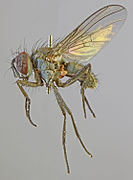
The Tephritidae are one of two fly families referred to as fruit flies, the other family being the Drosophilidae. The family Tephritidae does not include the biological model organisms of the genus Drosophila, which is often called the "common fruit fly". Nearly 5,000 described species of tephritid fruit fly are categorized in almost 500 genera of the Tephritidae. Description, recategorization, and genetic analyses are constantly changing the taxonomy of this family. To distinguish them from the Drosophilidae, the Tephritidae are sometimes called peacock flies, in reference to their elaborate and colorful markings. The name comes from the Greek τεφρος, tephros, meaning "ash grey". They are found in all the biogeographic realms.

The Anthomyiidae are a large and diverse family of Muscoidea flies. Most look rather like small houseflies. Most species are drab grey to black. Many Pegomya are yellow, and some members of the genera Anthomyia and Eutrichota are patterned in black-and-white or black-and-silvery-grey. Most are difficult to identify, apart from a few groups such as the kelp flies that are conspicuous on beaches.
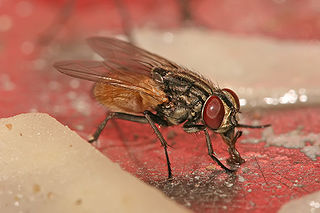
Muscidae are a family of flies found in the superfamily Muscoidea.

The Lonchaeidae are a family of acalyptrate flies commonly known as lance flies. About 500 described species are placed into 9 genera. These are generally small but robustly built flies with blue-black or metallic bodies. They are found, mainly in wooded areas, throughout the world with the exception of polar regions and New Zealand.
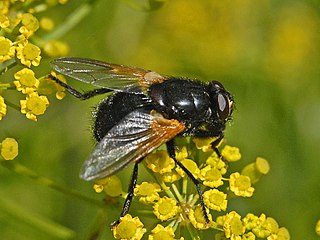
Mesembrina meridiana, sometimes known as the noon fly or noonday fly, is a species of fly in the family Muscidae.

Muscina is a genus of flies that belongs to the family Muscidae, currently consisting of 27 species. They are worldwide in distribution and are frequently found in livestock facilities and outside restrooms. The most common species are M. stabulans, M. levida, and M. prolapsa. Muscina flies commonly breed in manure and defecate on food, which has been linked to the spread of some disease and illnesses. The occurrence of Muscina larvae on dead bodies has led to their regular use in forensic investigations, as they may be used to estimate the time of death. Research have shown the prevalence of certain species of Muscina flies as vectors of diseases such as poliomyelitis.
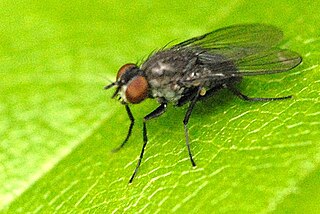
Coenosia is a very large genus of true flies of the family Muscidae. Coenosia are known as tiger flies since they are predators and hunt many kinds of insects and other invertebrates.

Psila fimetaria is a species of fly, a member of the family Psilidae.

Sepedon sphegea is a Palearctic species of fly in the family Sciomyzidae, the marsh flies or snail-killing flies. The larva feeds on aquatic snails and as an opportunist on other invertebrates. The habitat of this species includes among many others, pond margins and damp meadows. It has a particular fondness for Iris pseudacorus which grow at the edges of the pond. Adults can be found all year long but the main flight period is from March to October.

Loxocera aristata is a species of fly and member of the family Psilidae.
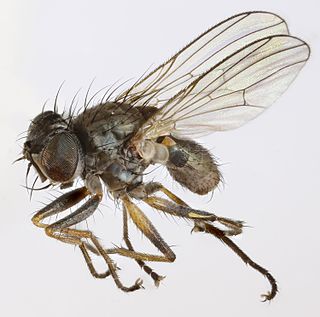
Coenosia antennata is a species of fly in the family Muscidae. It is found in the Palearctic.
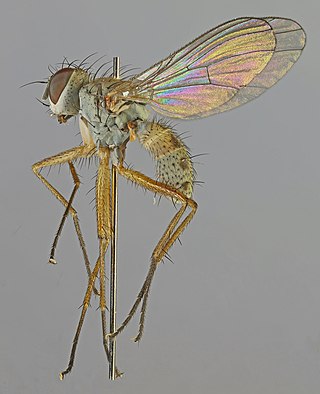
Coenosia testacea is a species of fly in the family Muscidae. It is found in the Palearctic.
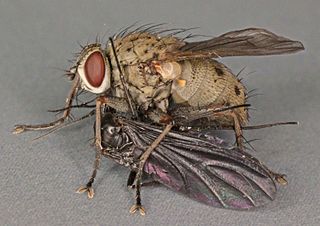
Coenosia tigrina, the hunter fly, killer fly, or common tiger fly, is a species of fly in the family Muscidae. Like other members of the genus, adults are predators that hunt flying insects, while larvae feed on earthworms. It is found in the Palearctic.
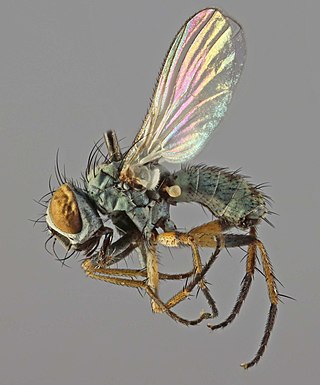
Coenosia verralli is a species of fly in the family Muscidae. It is found in the Palearctic. The name honours George Henry Verrall
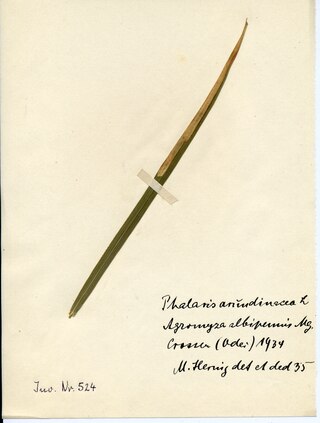
Agromyza albipennis is a species of fly in the family Agromyzidae. It is found in the Palearctic. Wings milky. Squamae with white borders and vestiture. Last segment of vein 5 (Cu A1 equal to twice the length of the precedent.- Long. : 2–3 mm. The larvae mines Poaceae
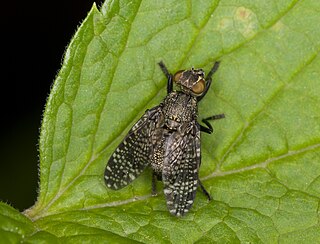
Platystoma seminationis, the dancing "kiss fly", is a species of fly in the family Platystomatidae.

Limnellia quadrata is a species of fly in the family Ephydridae. It is found in the Palearctic . It is 2 or 3 mm long and has distinctively patterned wings. It is found in meadows.

Paykullia maculata is a species of fly in the subfamily Rhinophorinae first described by Carl Fredrik Fallén in 1815.
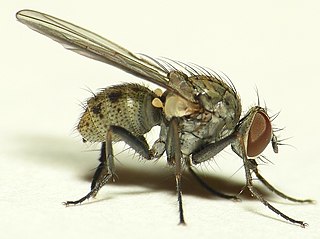
Coenosia humilis, the tiger fly, is a species of house flies, etc. in the family Muscidae. It is found in Europe and Antarctica.

Exsul singularis, the bat-winged fly, is a species of fly that is endemic to New Zealand, first described by Frederick Hutton in 1901. The males have enormously expanded wings. The species is found in the south-western South Island and occurs mostly in high-altitude meadows near streams. It preys on soft-bodied flying insects and is believed to uses its wings to increase its body temperature to offset the cool temperatures of its alpine habitat.

